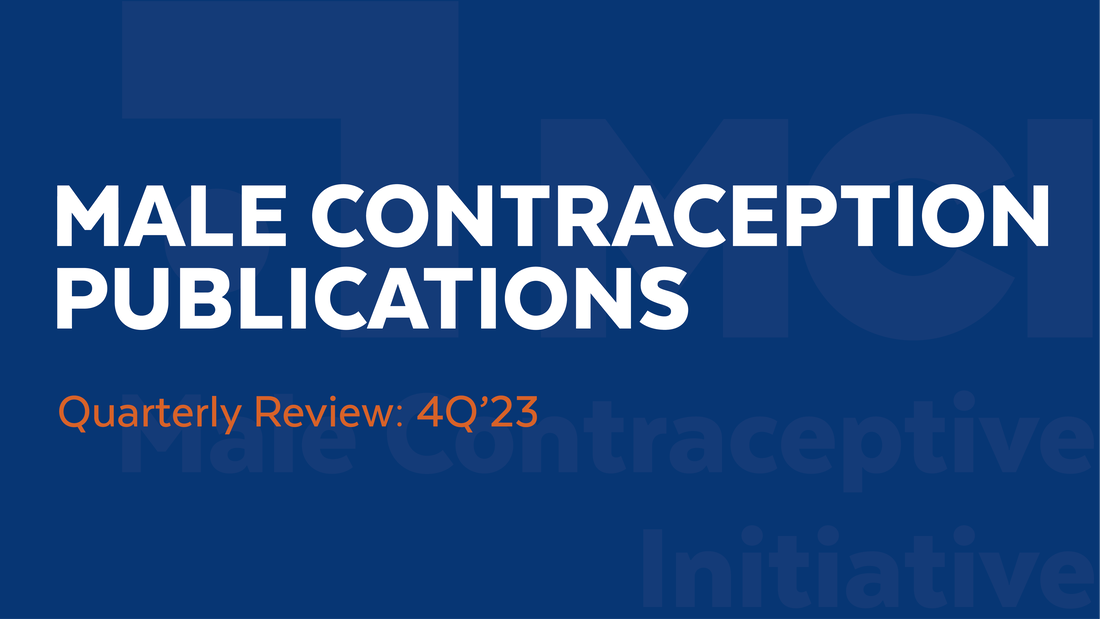|
This blog series highlights pertinent publications that were featured in MCI's monthly newsletter editions in the fourth quarter of 2023. The purpose of this blog is to report interesting or relevant work from MCI Fellows, Grantees, staff members, and other community authors in the field of male contraception. Despite various contraceptive options for women, the high unintended pregnancy rate persists globally. Only 20% of contraceptives are male-directed, reflecting limited availability and efficacy. Over 50% of men and 90% of women desire reversible male methods. These guidelines by the European Society of Andrology and the American Society of Andrology aim to assess the status regarding male contraception and offer evidence-based recommendations for new male contraceptive development. The 60 graded recommendations cover communication, behaviors, barrier methods, semen analysis, contraceptive efficacy, physical agents, surgical methods, actions before initiation, hormonal and non-hormonal methods, vaccines, and social and ethical considerations. Encouraging efficient and safe reversible male-directed methods is crucial for family planning in evolving gender dynamics. This publication from new MCI Fellow Xiaofang Huang identifies a new component of the sperm-specific CatSper calcium channel, CATSPERθ, which is essential for CatSper channel assembly during sperm tail formation. Acting as a scaffold for the pore-forming subunit CATSPER4, CATSPERθ is localized at the CatSper dimer interface, self-interacting and potentially facilitating dimer formation. This study provides insights into the CatSper channel assembly and elucidates the physiological role of CATSPERθ in sperm motility and male fertility, as male mice lacking CATSPERθ are infertile because the sperm lack the entire CatSper channel from sperm flagella, rendering sperm unable to hyperactivate. The sperm-associated protein epididymal protease inhibitor (EPPIN) is a promising target for non-hormonal male contraception, and MCI has supported the work of Eppin Pharma Inc in developing EP055 as a novel male contraceptive. This publication outlines interactions between EPPIN and SEMG1 as well as EP055 and other molecules through molecular dynamics simulations, providing insight into the design of new EPPIN binding compounds. Hot spot residues for binding were located in EPPIN's WFDC and Kunitz domains, with hydrophobic and hydrophilic residues allowing membrane anchoring. Targeting these residues could aid in designing EPPIN ligands for effective spermiostatic compounds, advancing non-hormonal male contraceptives and supporting contraceptive responsibility sharing. Retinoic acid receptor alpha (RARa) is a target being developed as a male contraceptive by YourChoice Therapeutics and the University of Minnesota. This publication outlines the synthesis and characterization of a set of RARa inhibitors, specifically, 26 retinoic acid analogs for their impact on spermatogenesis and fertility using a transactivation assay. Chromene amide analog 21 emerged as the most potent and selective retinoic acid receptor α antagonist. Despite favorable physicochemical properties and a promising pharmacokinetic profile, oral administration of compound 21 at low doses demonstrated modest effects on spermatogenesis without impacting fertility in mouse models. Increasing the dose and duration didn’t further enhance spermatogenic inhibition, which may suggest that 21 is not a suitable candidate for further exploration in affecting male fertility. The narrative review highlights the historical burden on women for contraception and family planning and examines current advancements in male contraceptive research. After over 60 years dominated by female-centric methods, promising hormonal and non-hormonal male contraceptives are emerging.This article outlines male contraceptive methods currently in development, with a focus on promising options either in the clinic or approaching human trials. Two hormonal methods are undergoing phase II clinical trials, including a transdermal segesterone acetate (Nesterone) plus testosterone gel and dimethandrolone undecanoate. These trials aim to measure the safety, efficacy, and suppression of spermatogenesis. Several non-hormonal methods also show potential in the preclinical stages. Despite challenges, the review anticipates the development of safe, effective, and reversible male contraceptives in the near future, marking a significant shift in reproductive choices. Building on work from MCI Fellow Candice Yap, this publication demonstrates that the male contraceptive target gene Dnali1 is required for sperm flagellum assembly, motility, and male fertility. Mutated Dnali1 male mice displayed impaired sperm motility and complete infertility, with disrupted ultrastructural sperm flagellum presenting asymmetrical longitudinal column distribution. Notably, infertile Dnali1-mutated mice achieved offspring through intracytoplasmic sperm injection, highlighting its potential as a therapeutic approach for Dnali1-associated male infertility. The findings underscore the significance of DNALI1 in sperm function, offering insights for diagnosing and counseling cases of DNALI1-associated human infertility. Are there any interesting publications about non-hormonal, reversible male contraception that you'd like to see featured? Please reach out to us and share your thoughts!
0 Comments
Your comment will be posted after it is approved.
Leave a Reply. |
Categories
All
Archives
June 2024
|
|
|
Donate to Male Contraceptive InitiativeYour generous donation makes a difference!
|
© Male Contraceptive Initiative. All rights reserved.



 RSS Feed
RSS Feed
